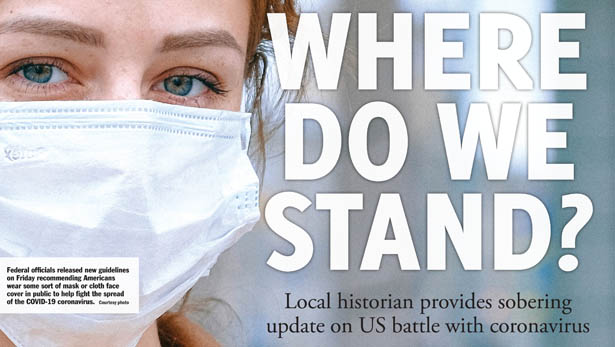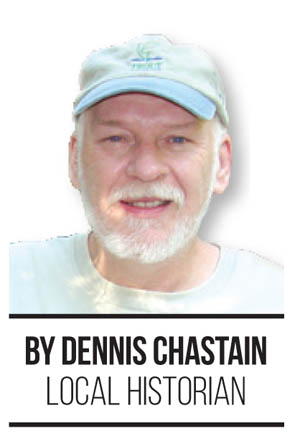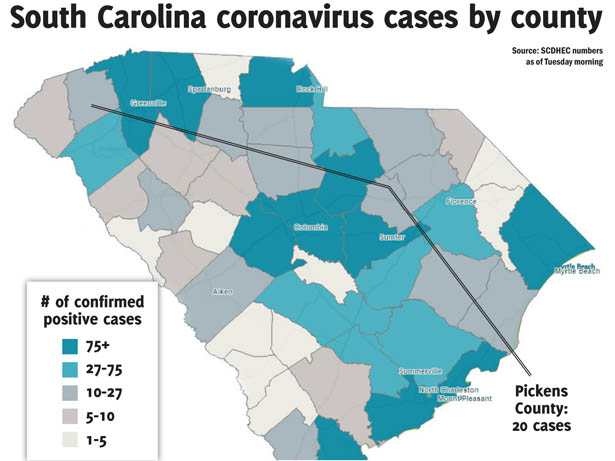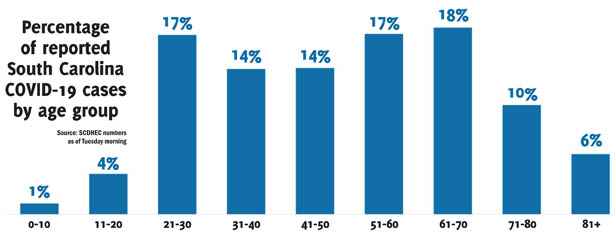Deadly pandemic intensifying across state, nation

First, the good news. Since I wrote the citizens’ guide to the coronavirus pandemic two weeks ago, I  have witnessed and been made aware of dozens of acts of kindness, heroism and community spirit all across the county. Many folks are hunkering down, making unprecedented sacrifices to save themselves and to help protect others from becoming infected. Your efforts will be rewarded tenfold, in many different ways.
have witnessed and been made aware of dozens of acts of kindness, heroism and community spirit all across the county. Many folks are hunkering down, making unprecedented sacrifices to save themselves and to help protect others from becoming infected. Your efforts will be rewarded tenfold, in many different ways.
But many have even gone beyond social distancing and self-preservation. Our longtime friends, Betty and Ed McDaniel, along with a number of dedicated volunteers and staff at Hagood Mill, are preparing and distributing free meals to those who have fallen on hard times due to the pandemic. Call Hagood Mill at 898-2936 for more information.
The School District of Pickens County has provided thousands of meals to students in every nook and cranny of the county who might otherwise go hungry.
 Many stores have stepped up to implement measures to help keep their shelves stocked, in some case limiting the number of customers in the store at any given time, and some have imposed special times for older folks to shop; all designed to help customers limit exposure to the virus.
Many stores have stepped up to implement measures to help keep their shelves stocked, in some case limiting the number of customers in the store at any given time, and some have imposed special times for older folks to shop; all designed to help customers limit exposure to the virus.
To all of you, I say in true Southern fashion, bless your heart. We appreciate all that you have done. I wish I had more time and space to recognize all those who have gone above and beyond the call, but we need to move on to the not-so-good news.
The Pandemic
The coronavirus (COVID-19) has now found its way throughout the length and breadth of the country. We are finding out that this new virus is extremely virulent and it has a remarkable ability to spread from one person to another.
Consider these sobering statistics. The director-general of the World Health Organization recently announced that it took 67 days from the time of the first reported case of infection until scientists recorded the milestone event of 100,000 people infected. In the next 11 days, that number doubled to 200,000. It took a mere four days to reach 300,000. Four days.
Globally speaking, last Friday we reached another grim milestone. More than 1 million people have now been infected by this pernicious virus. Here in the U.S., we have now exceeded China in total number of cases, and our country is the new ground zero in terms of the worldwide pandemic.
We now have a total of 10,000 deaths of our fellow American citizens from this pandemic. Keep in  mind that every one of those fatalities represent someone’s brother or sister, mother or father, or the cherished grandma or grandpa of a tearful child who doesn’t really understand what is going on, but is heartbroken.
mind that every one of those fatalities represent someone’s brother or sister, mother or father, or the cherished grandma or grandpa of a tearful child who doesn’t really understand what is going on, but is heartbroken.
We also know that at least a part of those deaths are front-line health care workers, the real heroes of this story. Let’s all take a moment to reflect on that fact and to collectively mourn for their loss.
Mitigation
We are now in the mitigation phase of trying to deal with all aspects of this pandemic. That means we are trying several things to slow the rate of spread and reduce the number of people affected. The good news is we now know that something actually makes a very real difference. The statistics are now compelling and all point in one direction — social distancing works.
Social distancing means essentially two things. The first is staying home as much as possible. Next is maintaining a safe space at all times and in all places from other people.
As of this past week, all but seven states had imposed “stay at home” orders, and early indications are that significant numbers of people all across the country are doing just that, and it is making a difference, saving tens of thousands of lives. The epidemiology experts with the White House coronavirus task force keep hammering home the message that social distancing is the primary tactic we have to combat spread of the virus, and people appear to be getting it.
This is certainly not based on any kind of scientific study, but it is worthy of note that if the chatter on social media right here in Pickens County is any indication, substantial numbers of individuals and families are in fact sheltering in place. And that is a very good thing for all of us.
Long-Range Forecast
No one knows what the future holds — no one. The best we can do is look at how this thing has played out in other countries, and what history has to tell us about the last pandemic (Spanish flu) the country experienced a century ago, along with the limited knowledge we have about the characteristics of this particular virus.
All things considered, I think we are probably looking at living with this pandemic at some level for about two years. That is assuming that we have a safe and effective vaccine by next spring or summer. Development of a vaccine typically takes 5-7 years, but efforts to develop and test a COVID-19 vaccine have been fast-tracked, and we will hopefully have a vaccine sometime between 10 and 18 months from now.
Keep in mind that even after a vaccine is developed and tested, it will take precious and agonizing months to actually administer it on a global scale. Drug manufacturers will have to take on the herculean task of producing roughly 8 billion doses to meet the global demand, and I can assure you there will be a great deal of squabbling over to whom and where those initial doses should be administered.
In the interim, experts predict that this first wave will peak in some of the earliest and hardest hit areas of the country, such as New York state, this week. Then there will a period of approximately the same amount of time that it took to get to the peak for it to subside. Then hopefully (but there are no guarantees) we may have a respite during the summer: July, August and possibly September. I must emphasize that is an optimistic forecast.
According to early indications from Australia and other locations in the Southern Hemisphere, where the summer season is just now ending, the results are mixed. Then a second wave, albeit less intense, could begin anew in the fall or winter.
As Dr. Anthony Fauci has said, “You don’t make the timeline, the virus makes the timeline.”
Hopefully, at some point along that timeline, we will have some new therapeutic agents that will prove to be safe and effective. There are a couple dozen pharmaceuticals being studied in double-blind studies, and a few are showing some efficacy. Keep in mind that medicinal therapeutics will not likely have any effect on the spread of the virus, but would represent a huge leap forward in terms of treating those infected with the virus. We’ll keep our fingers crossed on that possibility. As of right now, we have nothing to treat the virus, and something is better than nothing.
Back Here At Home
I really, really hate to be the bearer of so much bad news, but I have one more item for those of us who reside in Pickens County. Because we are among the last areas of the state and the country to be affected in a profound way, we will likely be among the last to experience a severe outbreak, recover and move on. It could happen at any time, but there is no way to be sure. If you look around at our nearest neighbors, North Carolina and Georgia, it probably won’t be long. It is happening now in Greenville, Columbia and Charleston, and it will eventually happen here.
The reason the coronavirus has this incredible capacity to rapidly go from a very few cases to epidemic levels in a short period of time is due to the fact that once inside a host, it has the ability to replicate itself at warp speed. Put that together with the fact that people who are infected do not show or experience symptoms for several days, and during this period they can unknowingly spread the disease to others. And add to that the fact that it tends to spread exponentially, as opposed to arithmetically.
Research has shown that, on average, infected victims spread the disease to 2.5 people. Then each of those people go on to spread it to another 2.5 people each, so you now have 6.25 people infected in the blink of an eye, and those 6.25 people go on to infect 15.6 people. And on and on it goes — you can do the math from there. So, in a remarkably short period of time, you can go from something that barely raises eyebrows to something that changes virtually every aspect of the world as we have known it for all of our lives.
The whole point of social distancing is to break that chain of infection by “starving” the virus of new hosts. The coronavirus can only survive over time if it has a continuous, unlimited number of uninfected hosts. By staying home and maintaining a safe distance from others, you deprive the virus of a new host. If enough people engage in this practice, over time, we can actually alter the course of even a pandemic.
This is what people are talking about when they talk about “flattening the curve.” When plotted on a graph, viral epidemics typically rise dramatically at first, then as the number of people infected increases, the numbers tend to level off or “peak.” Then the numbers start to decline at about the same rate they initially increased. By limiting the number of people available to infect, we can shorten the time to reach the peak and lower the total number of people that become infected. That’s why everyone keeps driving home the message that social distancing is the most powerful tool we have to get control and mitigate the overall impact of this historic pandemic.
Late-Breaking Developments
This past weekend in a surprise news conference, U.S. Surgeon General Vice Admiral Jerome Adams issued a dire warning. He said that this week would be, “A Pearl Harbor moment, a 9/11 moment.” He went on to say that this week would be the “hardest and saddest week for most Americans’ lives.” This ominous warning was apparently based on the fact that a number of major hotspots around the country are about to peak at or about the same time. This will result in numbers of new cases, hospitalizations and deaths that will be shockingly high. So be advised, this is going to be a rough week in the course of the coronavirus pandemic.
It is important to understand that while those hotspots will in fact peak during this time frame, there are other potential hotspots far short of peaking. Pay attention to Albany, Ga., for example, where a major outbreak was caused by large attendance at two funerals. Then there is Florida, where the numbers are already disturbing. So, one after another, each area in its own time will follow the now well documented chain of events from a few infected individuals to a full-blown outbreak. Social distancing will make a difference, but the degree of that difference will depend on a number of factors, including how far into the pandemic a “stay at home” order was issued, and how high the percentage of compliance has been for that area.
On Monday of this week, S.C. Gov. Henry McMaster finally issued his long-awaited “stay at home” order, joining the large majority of other states that imposed their orders in recent weeks. I am not going to offer a critique of the order except to say better late than never. It will make a difference and will save lives. The main takeaway is that this official order puts the weight of law behind social distancing and provides an affirmation for all South Carolinians that we have entered a perilous new phase of the pandemic in our state, and that social distancing is the most important thing we can do.
Officials from Prisma Health briefed legislators last week that according to their own modeling, we are poised to reach a peak of new cases in the Palmetto State in about 3-4 weeks. Hopefully, Gov. McMaster’s order will help flatten the curve and shorten the overall duration of the most intense phase of pandemic in our area. Time will tell. You can track the number of cases in South Carolina by zip code at scdhec.gov. There is a clickable link under the heading, “Positive Cases Indicated by Zip Code.”
Face Masks
Last Friday, the White House coronavirus pandemic task force and the CDC announced new guidance indicating that we should now be wearing some sort of cloth face cover. The advisory is based on new evidence indicating that transmission by aerosols is more important than previously thought.
It is still true that the heavier droplets, which fairly quickly fall to the floor or some horizontal surface, represent the primary threat to anyone standing in close proximity. Thus, the need for maintaining a six-foot safety zone at all times.
This new information pertains to the finer, lighter aerosols that were originally not considered to be an important risk factor, except in small clinical settings like hospital rooms and offices. It now turns out that aerosols linger in the area longer than previously thought and can in fact represent a threat that can be mitigated by wearing a mask or some form of face cloth.
Many of us already have at least one of the coveted N-95 face masks. We have been using them for years for woodworking, house cleaning and even cutting the grass. If you have one, wear it anytime you go to any public place.
We now know that you can catch the virus even from an up close and personal conversation with an infected person, even though they may not know they are contagious. When we speak, we release a cloud of moisture-laden mist. If there is coronavirus in that mist, you could easily breathe it in. So don’t forget to maintain a minimum of six feet distance, even when you wear your mask.
If you do not have an N-95 mask, you can easily make your own cloth mask. There are a number of patterns available on the internet. My wife, Jane, is sewing masks for friends and relatives as I write this.
There are a few precautions that you need to take if you decide to use a mask or cloth covering. First, be careful how you put it on and take it off. If the mask gets contaminated with virus particles, you can easily get it on your hands while donning or removing the mask, and you will have defeated the purpose of wearing it. Pinch it at the nose and pull it up and over your head, and you should be fine. Then immediately wash your hands with soap or apply hand sanitizer to your hands.
Also, if you plan on re-using the mask, you will need to decontaminate it after each use. You can do that by spraying a fine mist of either a weak solution of household bleach or hydrogen peroxide on the outside of the mask. Just remember that either one of those reagents will bleach your clothing or any other fabric. Place the mask in a kitchen sink or some other nonporous surface before treating. Finally, you can place the treated mask out in the sun to dry. The old saying, “Sunlight is the greatest disinfectant” is actually true.
I am going to leave you with this sad and sobering thought. When this is all over, there will be two groups of people in this country — those who survived and those who did not.
The clinical picture for many of those afflicted with the COVID-19 virus is so awful, so nightmarish, that I am not going to describe it here. Rather, I will simply say that no one should have to die alone, yet that is happening on an hourly basis, 24 hours a day, seven days a week, all across this country.
Remember that no one is immune to this novel coronavirus. We all have a compelling incentive to do everything we can to avoid contracting this pernicious, lethal virus and to help keep others from getting it. Do it and do it now. And continue to pray without ceasing for our country.

























